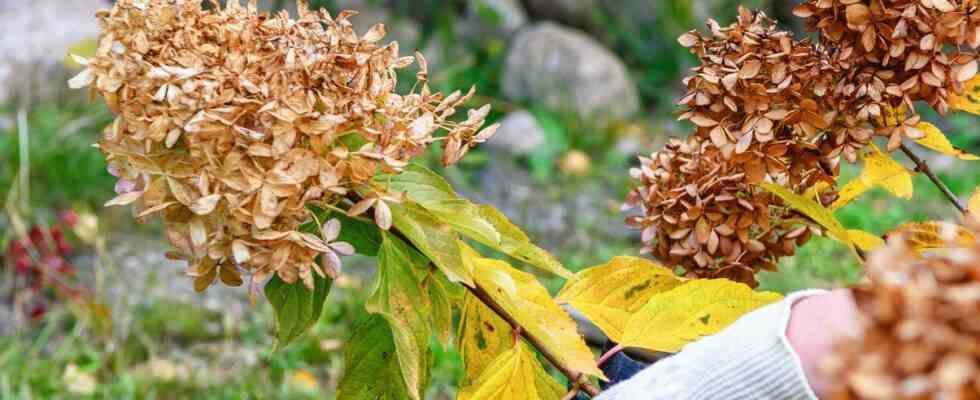The withering of flowers
Whatever the plant concerned, its flowers follow a normal life cycle which breaks down into different stages from bud to withering. Coming back to the hydrangea, a distinction should be made between the normal withering of its flowers and their premature wilting due to a watering problem, disease, etc. In the latter case, it will also be necessary to determine the cause to solve it.
Should dead flowers be removed?
No categorical answer can be given to this question, because there are two schools: some people prefer to keep them because they find them aesthetic and think that they will protect their plant from the winter cold, others do not like their aspect and prefer to cut them as they go or at the end of the flowering period.
In general, it is recommended toremove faded flowers from the plant in order to benefit from a more robust plant. Don’t worry, it won’t harm the plant if you do it right. This operation, which consists in simply removing the faded flowers, is called “deadheading” by the English, great specialists in the cultivation of hydrangeas, and has nothing to do with pruning, which consists of shortening the branches of the shrub.
Why cut dead flowers?
We have just seen it, you have the choice between cutting or not the faded flowers of your hydrangea. To help you make your decision, know that the fact ofremoving faded flowers as you go can be beneficial for your shrub, because it will prevent it from exhausting itself for nothing. And for good reason, by removing the dried flowers, the plant can concentrate its energy on its development and on that of the flowers that are not yet fully open.
Plus, your plant will look prettier and cleaner without its faded flowers.
Does removing faded flowers make the hydrangea bloom again?
You should know that the hydrangea blooms only once per season, except for a few varieties which are exceptions and can flower twice. Thus, if the deadheading makes it possible to have more beautiful hydrangeas and with a better growth, this practice will not cause your plant to bloom again.
You can therefore cut off the faded flowers because it is favorable to the plant from an aesthetic point of view and to improve its growth, but that’s it!
And if we do not cut the faded flowers of the hydrangea?
We’ve seen it, you’ve got it all the possibility of not cutting faded flowers of your hydrangea. This means that if, given the size of your shrub, you cannot easily reach the faded flowers to cut them or if you like the look of the faded flowers and want to keep them, it will not have any serious impact on your plant.
These flowers will continue their life cycle until the end, and next year you will still enjoy a new flowering, provided you remove them in early spring. You can therefore choose to let the flowers dry on your plant, especially in regions with harsh winters, as they will protect your plant from the cold.
When to cut faded flowers?
If you have opted for deadheading, i.e. the cutting of faded flowers, you can do this throughout the flowering period to delete them as they wilt or wait until there are several to eliminate. In fact, it’s as it suits you and according to the time you have. However, be aware that to keep a shrub clean and help it keep your energy for good growthit is best to give preference to the removal of faded flowers throughout the flowering season.
However, do not, under any circumstances, cut faded flowers in winter, because they then play the role of protectors against the cold for the buds which are preparing to emerge in their place.
How to cut faded flowers?
For once, there is a categorical answer and you have no choice! To cut the faded flowers, you will need a sharp pruner. Take the time to examine the stem the faded flower is on so you don’t risk damaging small buds, especially when removing flowers before August. Cut the stem just above a pair of healthy buds. In any case, be sure to leave at least 30 cm of stem.

